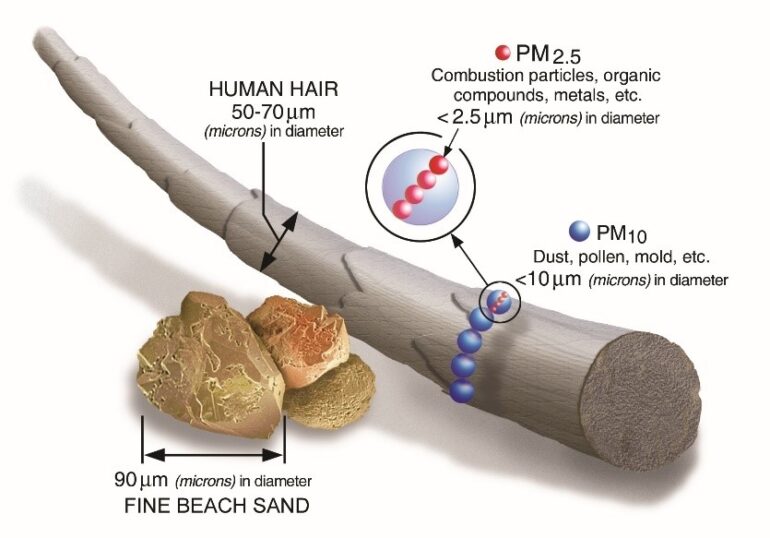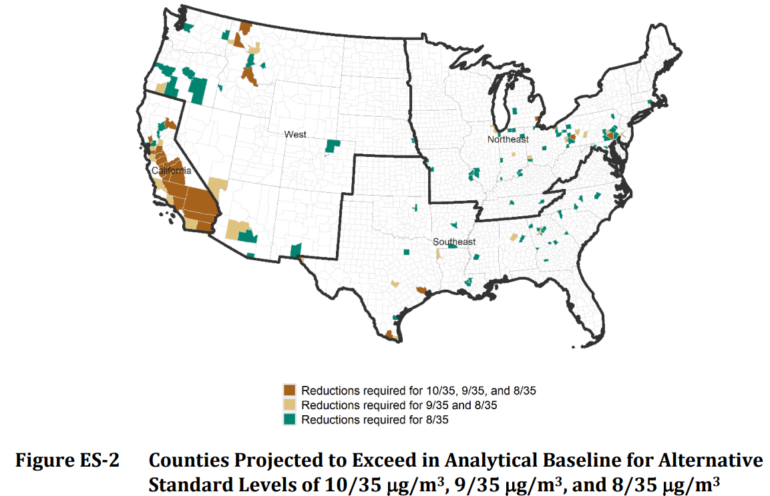On January 6, 2023, the U.S. Environmental Protection Agency (the EPA) released a pre-publication copy of a Proposed Rule, which will lower the annual National Ambient Air Quality Standard (NAAQS) for fine particulate matter (PM2.5). PM2.5 refers to PM with a diameter of 2.5 microns or less, which is about 3-5 percent of the width of a human hair.

Source: https://www.epa.gov/sites/default/files/2016-09/pm2.5_scale_graphic-color_2.jpg
Sources of PM2.5
Sources of PM2.5 are varied and complex. Some fine particulate is emitted directly, such as from fuel combustion by vehicles or power plants, or from certain industrial and agricultural activity. But a significant amount of fine particulate is also created when gasses emitted by such or other sources react in the atmosphere. The picture is further complicated by significant sources outside familiar regulatory targets, particularly forest fires, as well as contributions from wind erosion of soils and minerals and international transport.
Revised PM2.5 Standards: Process and Proposal
Under the Clean Air Act, the EPA is required to periodically review all NAAQSs and revise them as necessary to protect public health (primary standards) and welfare (secondary standards), based on available scientific evidence and technical information. As a practical matter, EPA has adopted two PM2.5 NAAQSs: one for short-term exposure (24 hours), and another for annual exposure. The current standards for PM2.5 were established in 2012 and affirmed in 2020. Thereafter, several parties petitioned the EPA to reconsider the 2020 decision, and in June 2021 the EPA commenced the re-evaluation process.
In evaluating whether to lower the annual standard for fine particulate matter, the EPA relied heavily on certain technical studies: the December 2019 Integrated Science Assessment for Particulate Matter, its May 2022 Supplement, and policy assessments prepared by EPA staff, as well as advice from the EPA’s Clean Air Scientific Advisory Committee (CASAC). According to the Integrated Science Assessment, fine particulate matter exposure at concentrations allowed by the current annual standard may lead to statistically significant adverse health effects, including respiratory and cardiovascular issues. The CASAC agreed with EPA staff policy assessments that this evidence calls into question the adequacy of the primary annual standard for fine particulate matter and recommended that the standard should be reduced accordingly.
The Proposed Rule would lower the primary annual standard for PM2.5 from its current level of 12 micrograms per cubic meter (12 μg/m3) to a level between 9 and 10 μg/m3. However, in the Proposed Rule the EPA also requests public comment regarding levels from 8 to 11 μg/m3.
The Proposed Rule would retain all other existing particulate matter standards (the primary 24-hour PM2.5 standard and the identical secondary standard; the secondary annual PM2.5 standard; and the primary 24-hour coarse particulate matter (PM10) standard and its identical secondary standard). However, although no changes are proposed to the 24-hour PM2.5 primary and secondary standards, the EPA will take comment on reducing them from the current 35 μg/m3 to as low as 25 μg/m3.
Concurrent with the proposed NAAQS changes, the EPA also proposes to revise its Air Quality Index, which provides information about daily ambient levels for PM and other pollutants, to improve public communications about the risks from fine particulate matter exposure. The EPA further proposes to modify the nationwide PM2.5 monitoring network to enhance protection of air quality in communities overburdened by air pollution.
Notably, in presenting the Proposed Rule, the EPA emphasizes the “environmental justice” (EJ) aspects in terms of communities potentially harmed by current levels of PM2.5.
Anticipated impact
The EPA’s Regulatory Impact Analysis document accompanying the Proposed Rule projects where air quality would not attain the proposed tightened annual PM2.5 standard, with the extent of impact depending on whether the standard is lowered to 10 μg/m3, 9 μg/m3, or 8 μg/m3. Under any of these scenarios, the most impacted state is California, particularly the Central Valley and southern California. Beyond that, impacts are highly scattered across the lower 48 states, and include several major urban areas.

Source: https://www.epa.gov/system/files/documents/2023-01/naaqs-pm_ria_proposed_2022-12.pdf
Outlook for final revised standards
Following publication of the Proposed Rule in the Federal Register, the EPA will accept public comment for 60 days. According to its January 6 press release, the agency plans to finalize the new standards later this year. Regardless of where the final standard lands, it is certain to be challenged in court.




 />i
/>i

